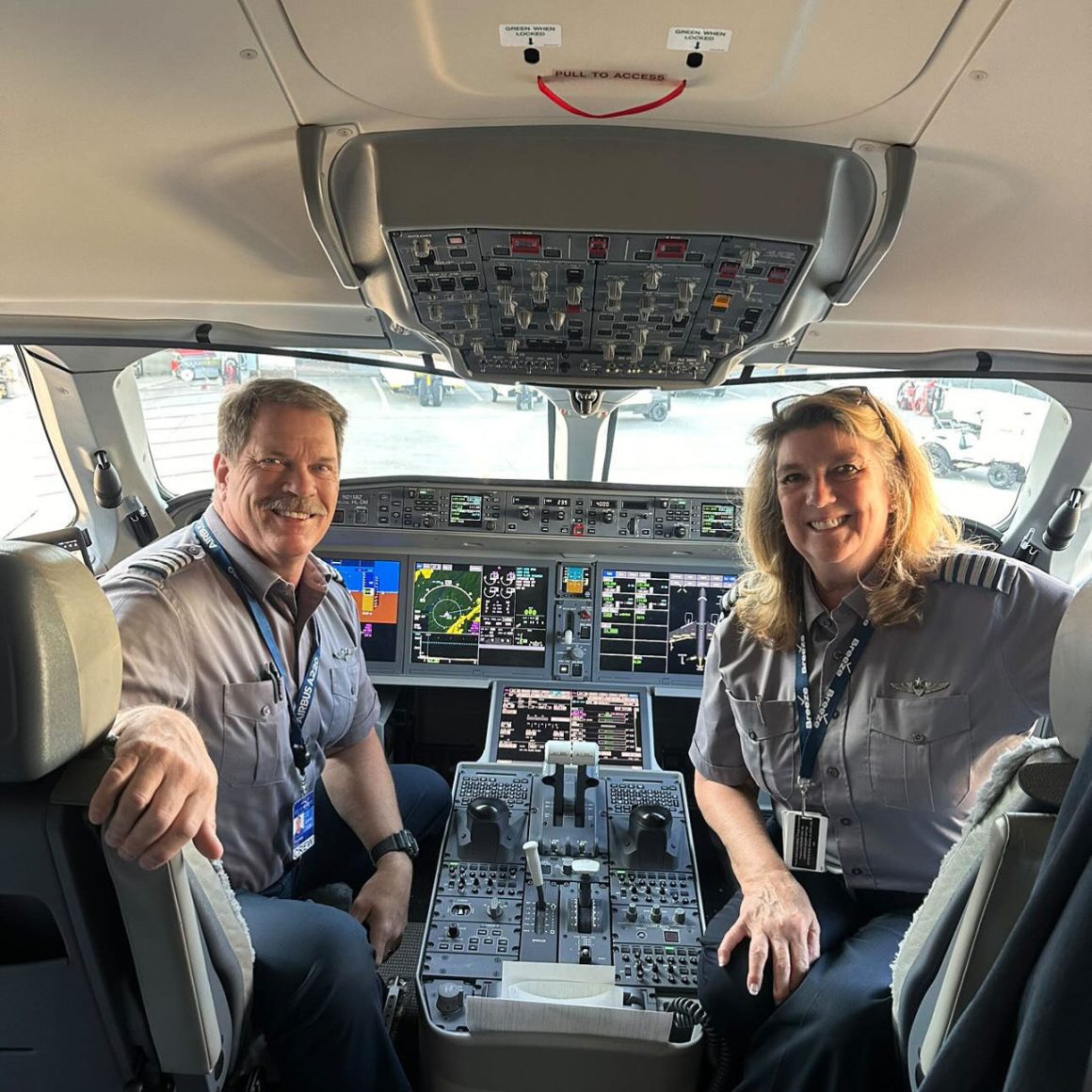Just over three years ago, Breeze Airways’ inaugural flight lifted off from Tampa International Airport (TPA) bound for Charleston International Airport (CHS) in South Carolina.
Since then, Breeze–a creation of Morris Air, Azul, and JetBlue founder David Neeleman–has made a Seriously Nice™️ splash in the world of low-cost carriers. I recently flew Breeze for the first time and wasn’t sure what to expect. But let me tell you: Breeze blew me away (pun intended).
Breeze Airways Will Soon Become the World’s Third-Largest A220 Operator
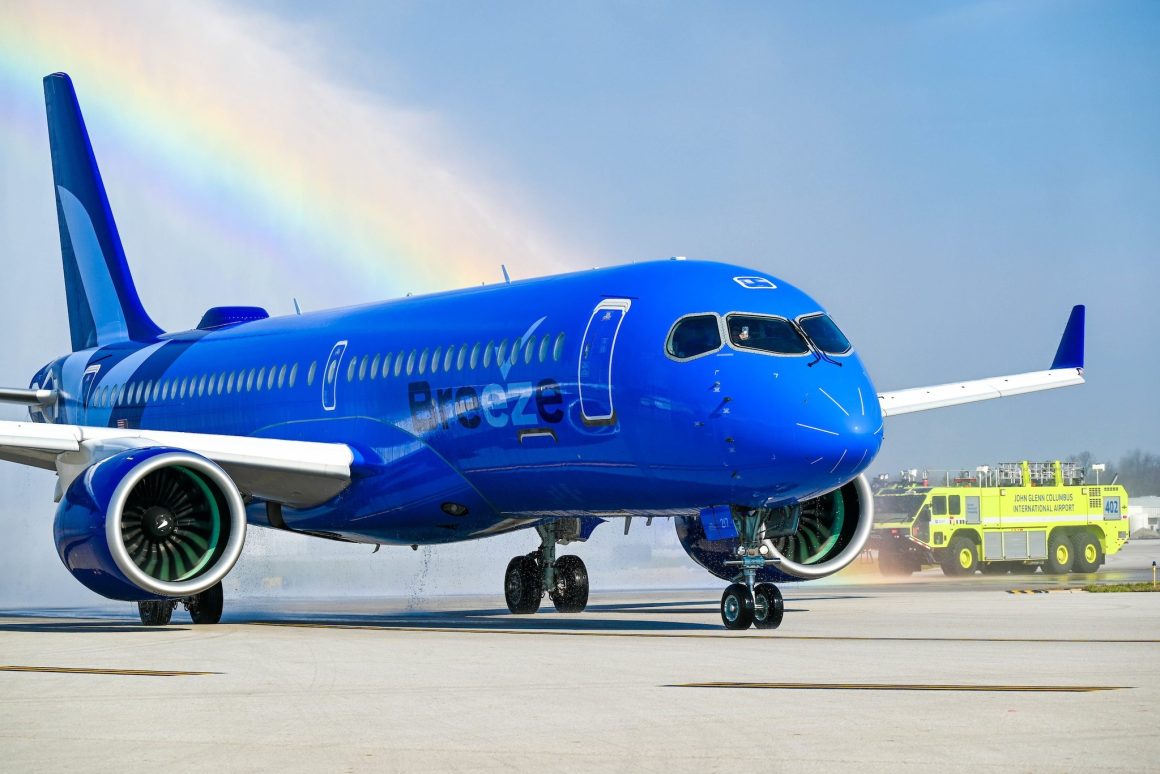
Breeze Airways is an ultra-low-cost carrier (ULCC) based in Cottonwood Heights, Utah, just outside Salt Lake City.
Neeleman launched Breeze in response to years of industry consolidation and reduced air service to smaller cities nationwide.

Originally called Moxy Airways, the airline changed its name to Breeze before its launch to avoid confusion with the Moxy by Marriott hotel chain. Neeleman’s vision was to create an airline with a traditional LCC fee structure, similar to Spirit and Frontier, but with two classes of service comparable to JetBlue.
Breeze primarily flies point-to-point routes to and from underserved airports, avoiding hubs.
Breeze operates without a hub airport but has crew bases in a number of locations:
- Charleston, SC | Charleston International Airport (CHS)
- Fort Myers, FL* | Southwest Florida International Airport (RSW)
- Hartford, CT | Bradley International Airport (BDL)
- New Orleans, LA | Louis Armstrong New Orleans International Airport (MSY)
- Norfolk, VA | Norfolk International Airport (ORF)
- Orlando, FL | Orlando International Airport (MCO)
- Providence, RI | Rhode Island T.F. Green International Airport (PVD)
- Provo, UT | Provo Airport (PVU)
- Tampa, FL | Tampa International Airport (TPA)
- Vero Beach, FL* | Vero Beach Regional Airport (VRB)
*RSW and VRB crew bases open this October.
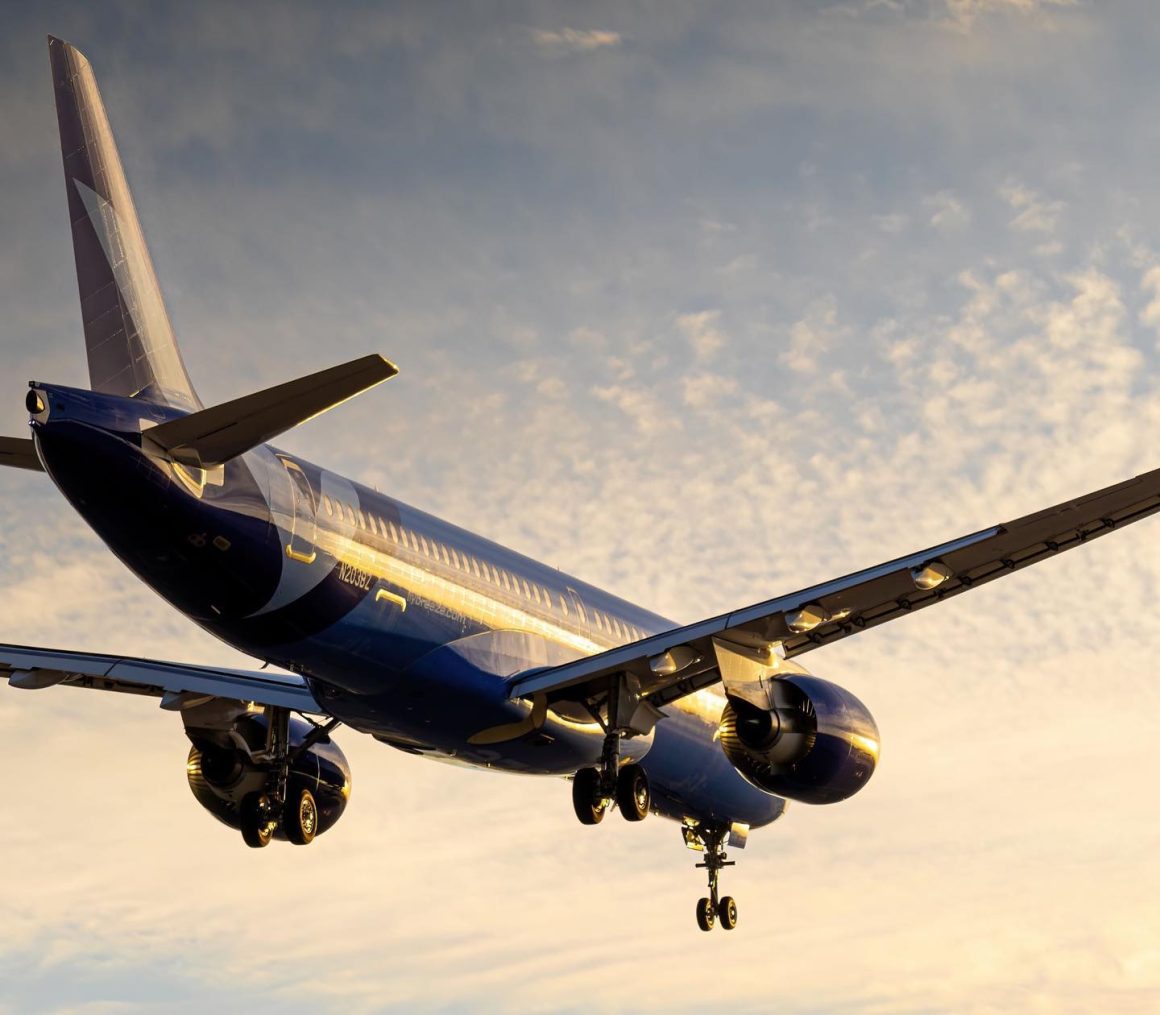
The company initially ordered 60 Bombardier CS300s (which later became the Airbus A220-300) ahead of its planned 2020 launch. The carrier was set to acquire Compass Airlines, but that deal fell through, pushing the launch to 2021. Breeze started operations with 13 leased Embraer ERJ-190/195 aircraft while waiting for the A220s to come online.
Breeze’s first flight took place on 27 May 2021, and the carrier has expanded significantly since then.
Today, Breeze operates a fleet of 40 aircraft serving 63 destinations across the United States. Its fleet includes 27 Airbus A220-300s, 10 Embraer ERJ-190s, and three Embraer ERJ-195s. As of this writing, Breeze has a total firm order of 90 A220s, with 27 already delivered. The additional A220s will position Breeze to become the third-largest operator of the type in the world.
By the end of 2024, Breeze plans to transition all scheduled service to the A220 and use its E190/195s exclusively for its robust charter service through at least 2026.
Earlier this year, Breeze surpassed five million total passengers, achieving a flight completion rate of 99.8%, a 74.5% on-time performance, and a mishandled bag rate of 0.27 bags per 100 bags loaded–one of the industry’s lowest rates. It also boasts the youngest fleet in the United States, with an average aircraft age of just over two years.
At just over three years old, this young airline has a lot going for it.
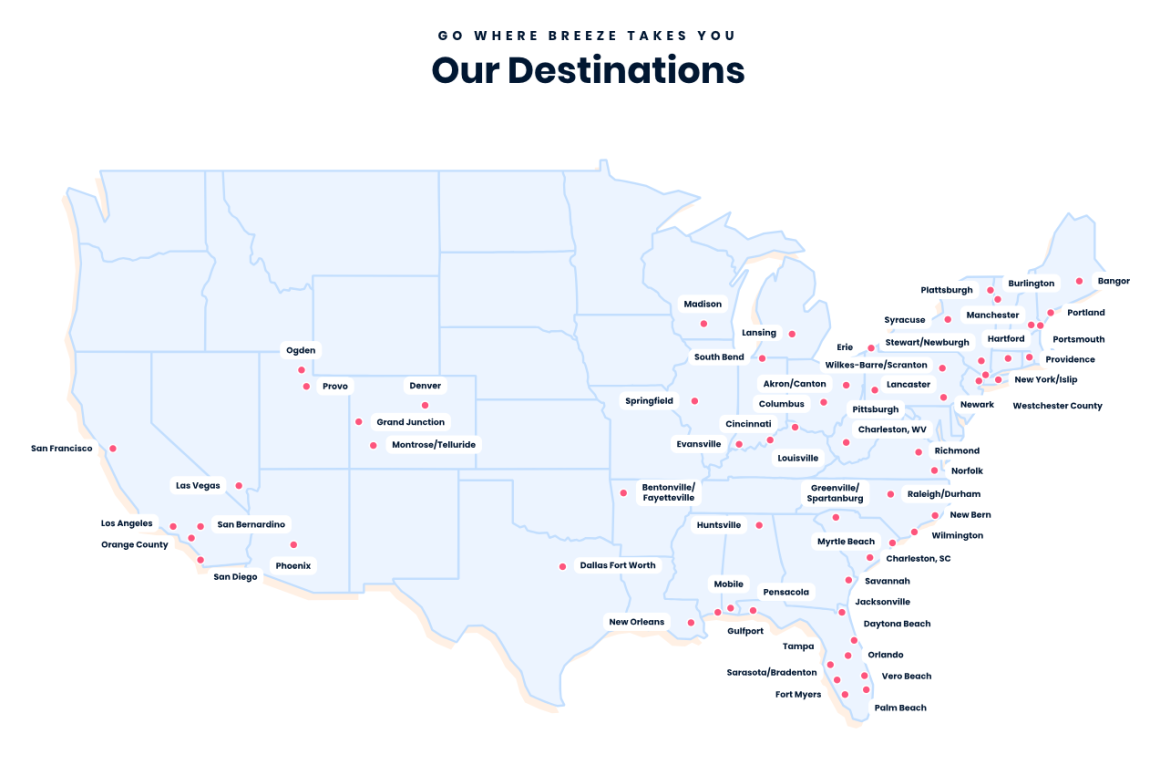
My Booking Experience with Breeze
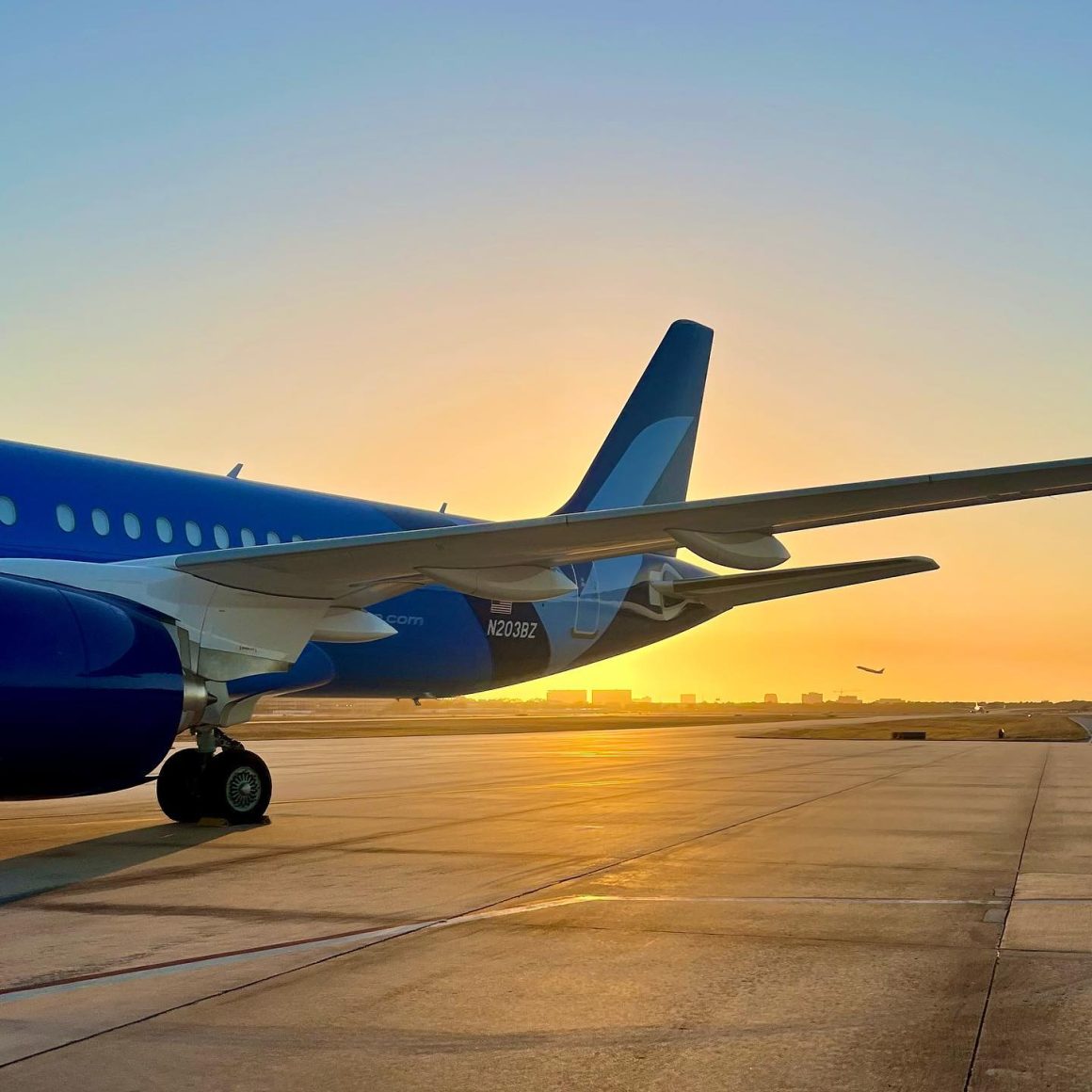
In this era of expensive everything, I needed a budget-friendly option for my family and me to fly to the Los Angeles area from Myrtle Beach, South Carolina, last month. During my search, I found an ad for Breeze Airways, which began service to Myrtle Beach International Airport (MYR) in February 2024.
Intrigued, I clicked on the ad and began looking for deals on Breeze. Unfortunately, the Breeze booking engine did not allow me to book a flight between MYR and LAX. But I did find a nonstop flight between CHS and LAX.
I booked the flight for my wife, son, and me for $258 per person roundtrip. Although the flight was from CHS, located about two hours south of Myrtle Beach, the price was right, and I loved that it was a nonstop flight.
As far as airline websites go, flybreeze.com is clean, easy to navigate, and highly intuitive. Booking a flight is quick and far less complicated than other airline websites.
Breeze Offers Four Fare Types and Two Classes of Service
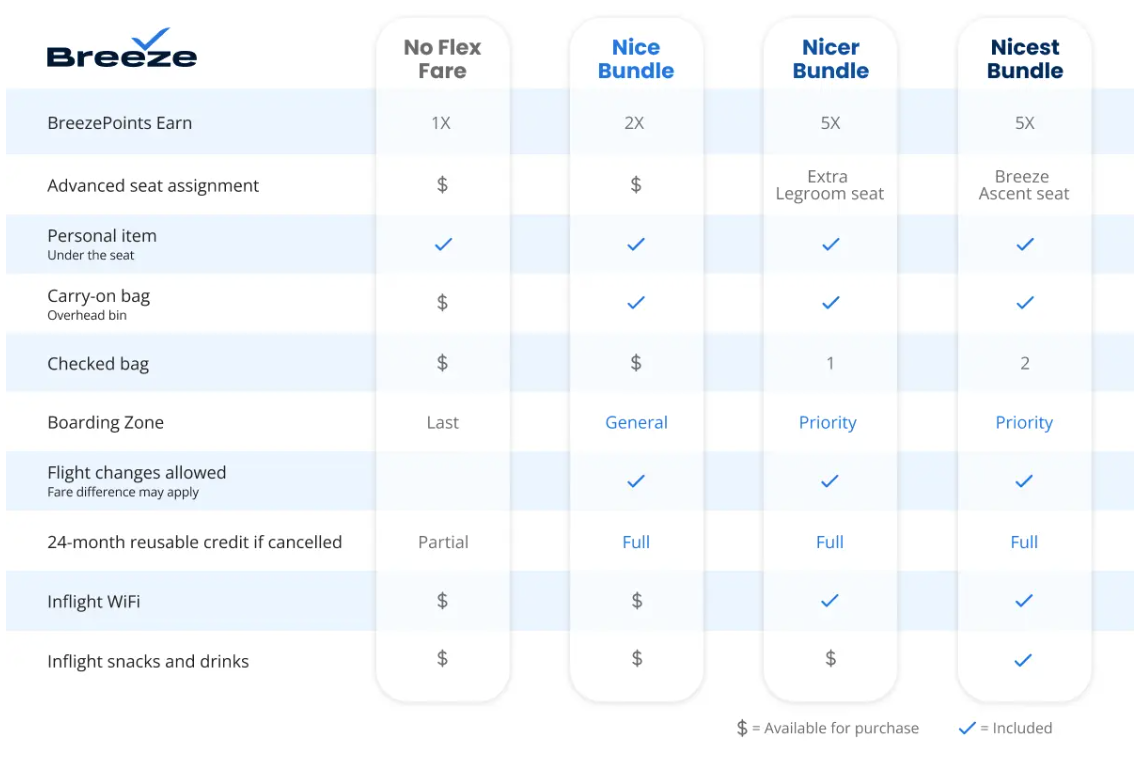
Breeze, which bills itself as America’s only “Nice Low-Cost Carrier (NLCC),” offers four fare options across two classes of service:
No Flex Fare: This is the cheapest option, which allows travelers one personal item. Everything else costs extra, including carry-ons, checked luggage, seat selection, and Wi-Fi. Itinerary changes are not permitted with this fare.
Nice: This is the fare I chose for my family and me. It allows more flexibility and includes a personal item and one carry-on. Travelers may change or cancel their itinerary anytime and receive credit towards a future Breeze flight.
Nicer: In addition to the benefits of the Nice fare, the Nicer fare is similar to most airlines’ premium economy sections. This option features seating with extra legroom, one free checked bag, priority boarding, and free Wi-Fi.
Nicest: Breeze’s first-class product, Breeze Ascent, features recliner-style seating with generous legroom. Food and drinks, including alcohol, are free. In addition, travelers may check two checked bags at no cost. Breeze Ascent is available exclusively on the carrier’s Airbus A220-300 aircraft.

Charleston Check-In

Our flight was an early evening departure out of CHS. We arrived at the airport at 1715 local time, exactly two hours ahead of our scheduled departure at 1915.
My wife checked us in 24 hours prior via the sleek and easy-to-use Breeze App, so check-in was quick and straightforward when we got to the airport. We had one checked bag and a car seat. For our flight to LAX, Breeze charged $40 for the checked bag, which we paid at the time of booking. Like most carriers, Breeze does not charge for strollers or car seats.
A carry-on would have cost $35, but we opted to bring only personal items on board to avoid the extra fee. As with most carriers these days, I highly recommend paying for baggage ahead of time. In Breeze’s case, adding a carry-on or checked bag at the airport would have cost $75 each.
We printed our bag tags, handed our baggage to the Breeze agent, and made our way to security.
Breeze is the First Airline in the United States to Offer Free Family Seating
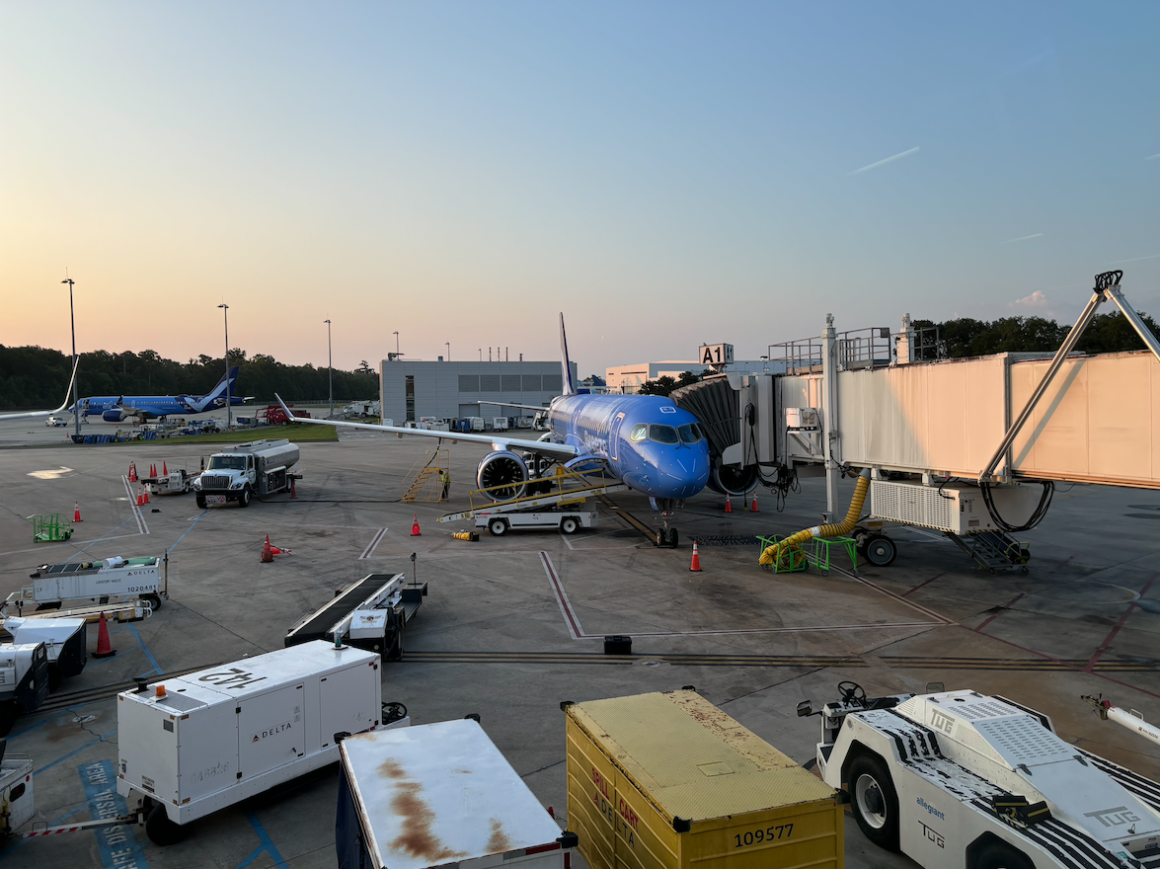
Once we cleared security, we made our way to the gate just in time to see our inbound aircraft arrive several minutes ahead of schedule from PVD.
The boarding area was surprisingly full for a Monday night flight to the West Coast from Charleston. The response to the CHS-LAX route has been overwhelmingly positive, prompting an increase from two to four weekly flights between the two cities. Breeze launched LAX service from CHS in the summer of 2023 as a seasonal route.
Breeze has invested heavily in CHS since its launch. The carrier, which considers CHS a focus city, boasts an average of 15 daily departures to 22 nonstop destinations.

After the inbound passengers deplaned and the prep began for the upcoming transcon flight, boarding for Flight 770 started promptly at 1855.
As a family traveling with a small child, we took advantage of early boarding. We made our way down the jet bridge and stepped on board the immaculate Airbus A220-300. Once on board, we were greeted warmly by one of three flight attendants who would be working our flight. The other two flight attendants were helping passengers find their seats as the plane began to fill up.
I was excited because this was my first time flying with Breeze and flying on an A220. Two things immediately caught my eye as I took my seat. First, the A220 is a beautiful aircraft. Delivered new to Breeze in October 2022, this A220 (reg. N216BZ) features 12 “Nicest” seats (Breeze Ascent) in a 2-2 configuration, 45 “Nicer” seats with extra legroom in a 2-3 configuration, and 80 “Nice” standard seats also in a 2-3 configuration. Breeze’s interior is simple but bold, crisp, and eye-catching.
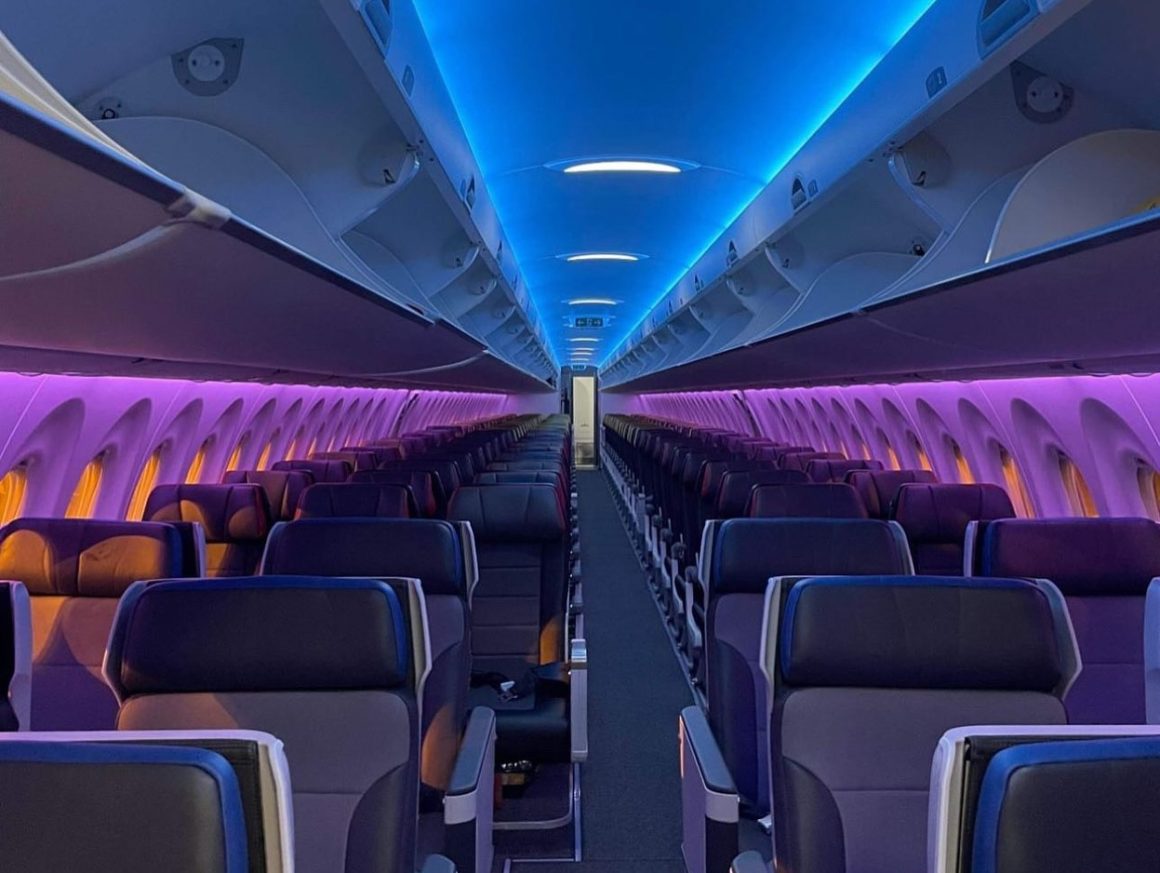
The other thing I noticed was the attire of the cabin crew. The all-male crew wore dark slacks with what appeared to be striped T-shirts and sleeveless vests. While this was not a bad thing, my first impression was that Breeze wanted to present a casual, comfortable, and modern image with its cabin crew.
We were seated in 25D, E, and F. One of the things I appreciate most about Breeze is its family seating policy. Each flight has a “family section” located in the last five rows of the aircraft. If you are traveling with a child, you can select your seats in this section in advance at no cost. Breeze is the first airline in the United States to offer this.
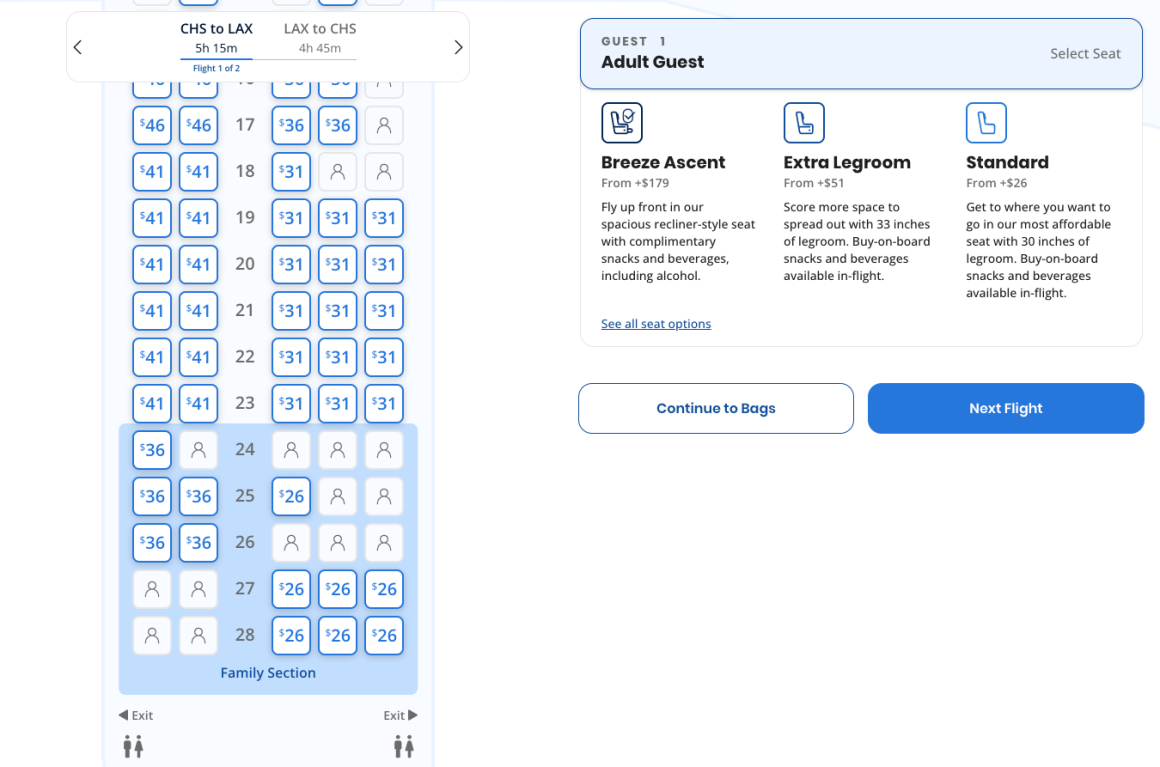
For everyone else, advance seat selection ranges between $10 and $59 for “Nice” seats, $30-$99 for “Nicer” seats, and $50-$399 for an upgrade to “Nicest” and Breeze Ascent. If you choose not to pay for advance seat selection, you will be assigned a seat for free at check-in.
An On-Time Departure

The smooth and efficient boarding process concluded five minutes before our scheduled pushback time. The crew secured the doors at 1918, and the captain greeted us over the PA system to inform us of some possible light to moderate chop during the first half of the four-hour, forty-eight-minute flight.
After a short fueling delay, we pushed back and began our taxi to Runway 15. We were number two for departure behind an American Airlines Boeing 737-800 to DFW. Once cleared for takeoff, we lifted off into the hazy South Carolina sky at 1941 local time. The Pratt & Whitney GTF engines practically whispered as we departed. As a first-time A220 passenger, I was thoroughly impressed with the sound (or lack thereof) of the engines at full throttle.
Immediately banking south and then west, we had a bird’ s-eye view of Boeing’s sprawling 787 factory at CHS. We continued our ascent until settling in at FL340 for our ride out west.
The Breeze In-Flight Experience

By this time, the first of two in-flight services had commenced. Breeze provides complimentary water, coffee, or tea. Everything else is available for purchase unless you’re in Breeze Ascent, where food and beverages–including alcohol–are free.
Non-alcoholic drinks begin at $4, while beer, wine, and other adult beverages start at $9.50. Standard snacks, such as chips and candy, cost $4.50, while premium snack boxes sell for $10. Although I did not purchase any food or drinks, I must say that the meat and cheese spread looked delicious.
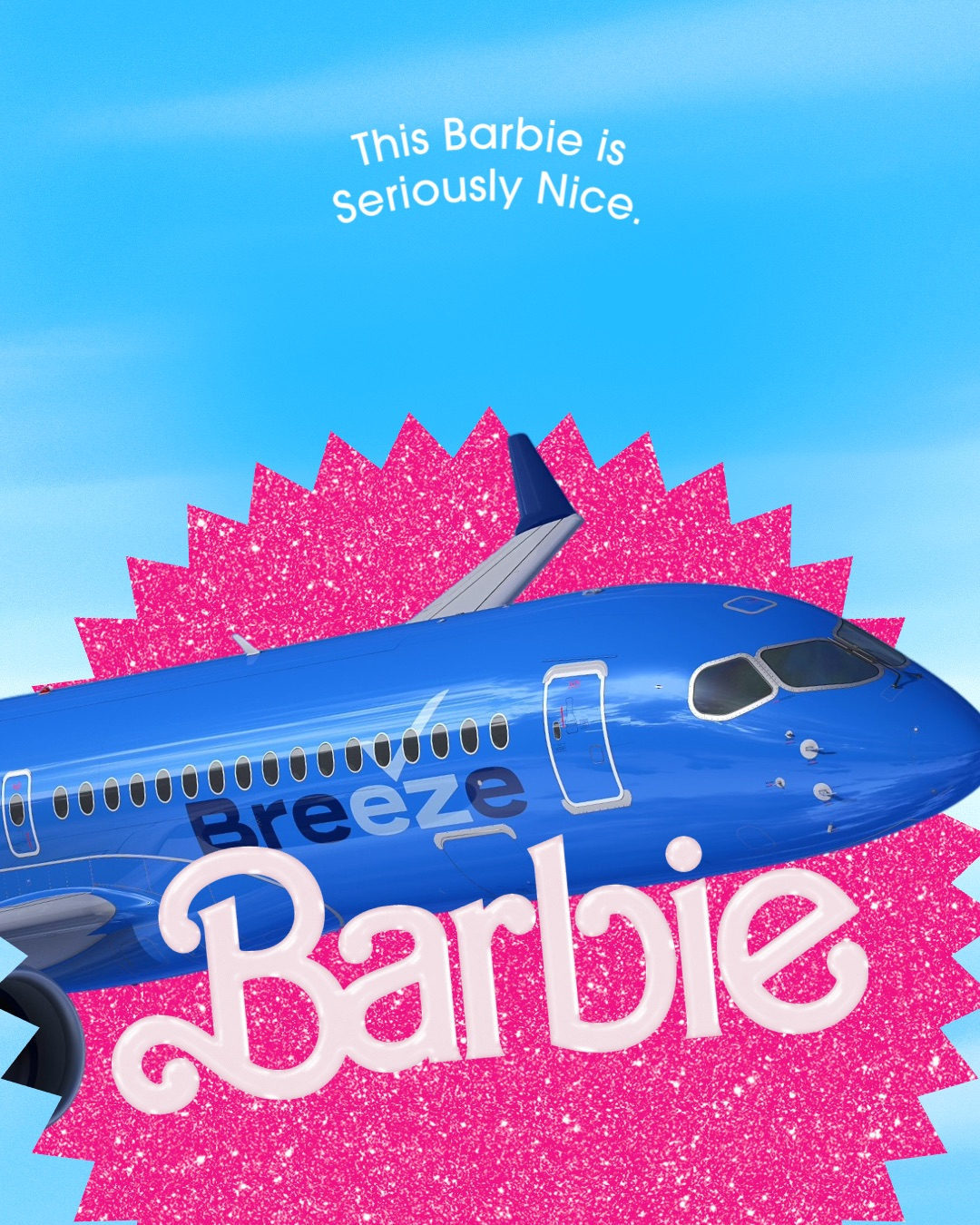
High-speed Wi-Fi is available to purchase for $8. Customers traveling on a Nicer or Nicest fare receive complimentary Wi-Fi. Messaging is free, as is in-flight entertainment on your device. The TV and movie selections are impressive and helped the time fly by (plus, I finally got to see what all the fuss with Barbie was about. Meh. Don’t judge me.) The Wi-Fi stopped working twice during the flight, but both outages were brief as the cabin crew quickly rebooted the system.
As of summer 2024, Wi-Fi is available on most of Breeze’s A220-operated flights. The carrier plans to equip all of its A220s with Wi-Fi by the end of the year.
Wi-Fi is not available on Breeze’s Embraer ERJ-190/195 aircraft. However, as mentioned earlier, the carrier is streamlining to an all-A220 fleet and has announced it will end scheduled E190/195 operations in early September.
Each seatback features a USB-C charging port, keeping my iPhone at full battery for the entire flight.
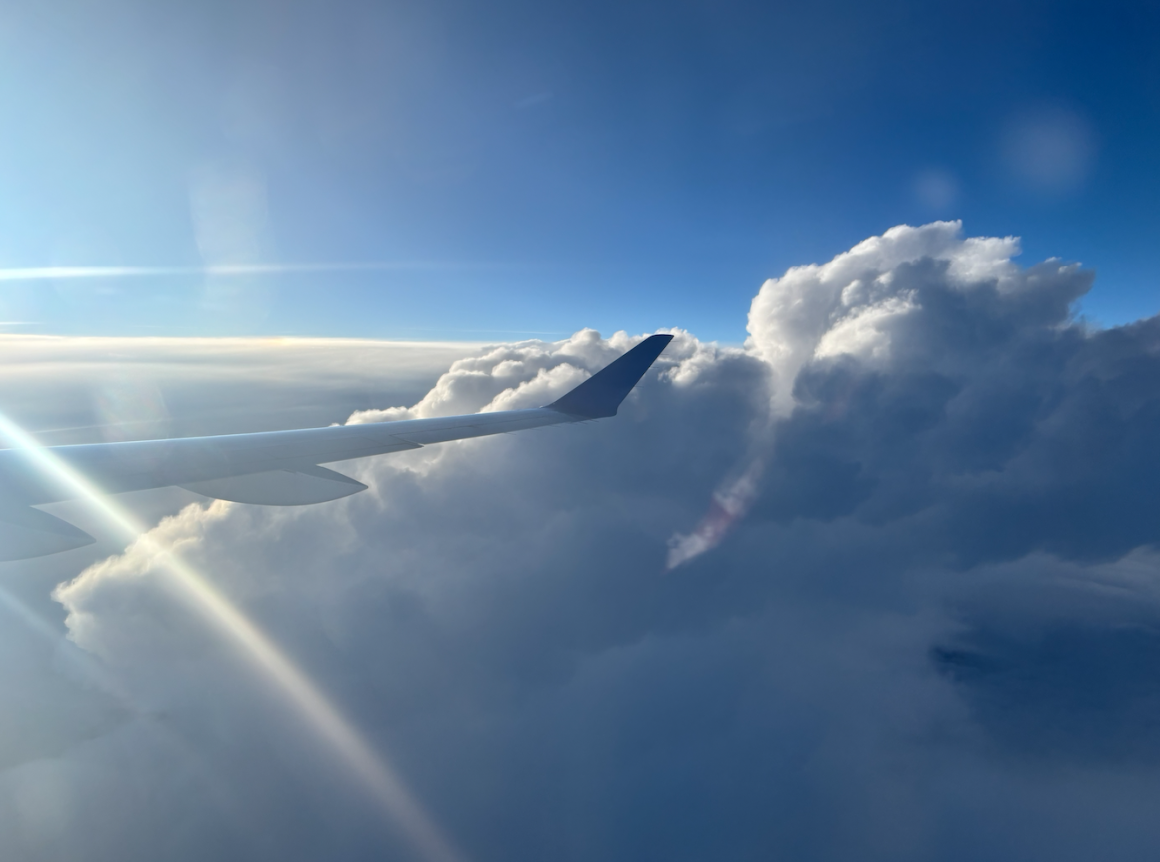
The A220’s extra-large windows provided spectacular views as we chased sunset across the southern United States. As expected, we navigated past some impressive storms and hit some light to moderate turbulence over northern Mississippi that necessitated a climb to FL360.
Thankfully, the weather soon cleared, and the second half of the flight was very smooth, which allowed the seat belt sign to remain off for the duration of the flight. As daylight faded, beautiful blue LED mood lighting illuminated the cabin.

I was particularly impressed with the cabin crew, as they all seemed to pay extra special attention to young flyers like my six-year-old son. Every time they passed by our row, they asked him how he was doing and gave him a high-five or a fist bump. One of the FAs even asked him what his favorite candy was, and he soon returned with a box of M&Ms, which I thought was an incredibly nice gesture. Toward the end of the flight, the same flight attendant presented my son with an airplane sticker (what happened to pins?) that he proudly affixed to his backpack. I was so impressed with the crew and their attention to ensuring our family had an enjoyable experience on board.
About an hour or so from landing, the cabin crew changed the color of the mood lighting and began the second service.
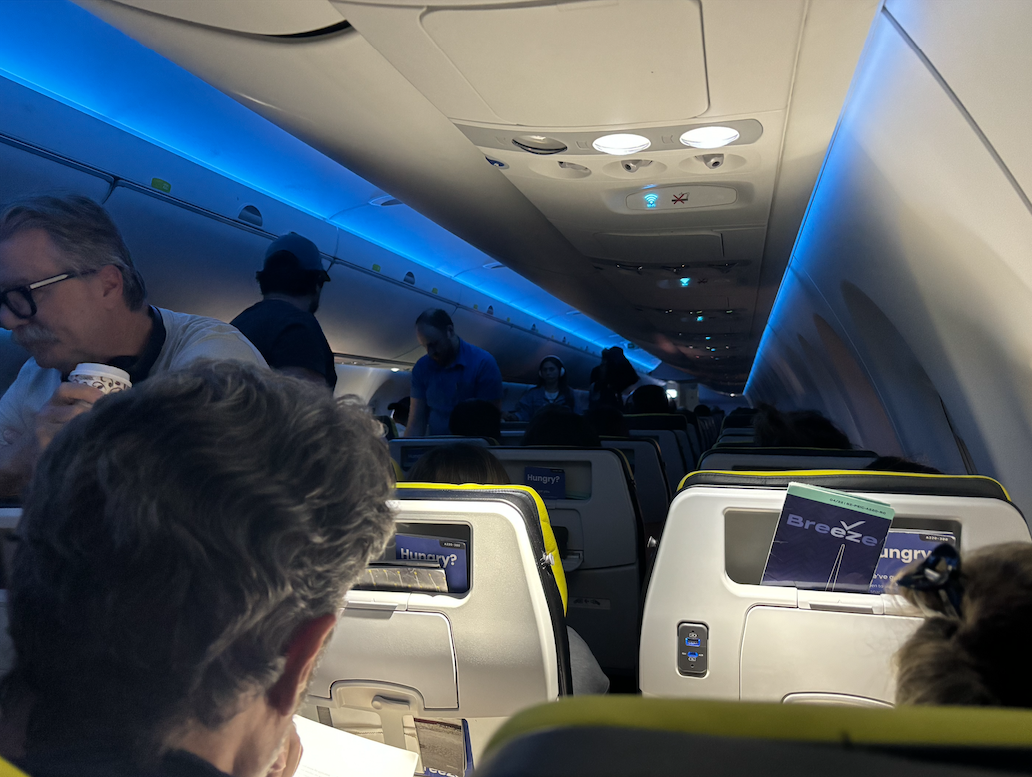
Arriving at the Hot Mess that is LAX
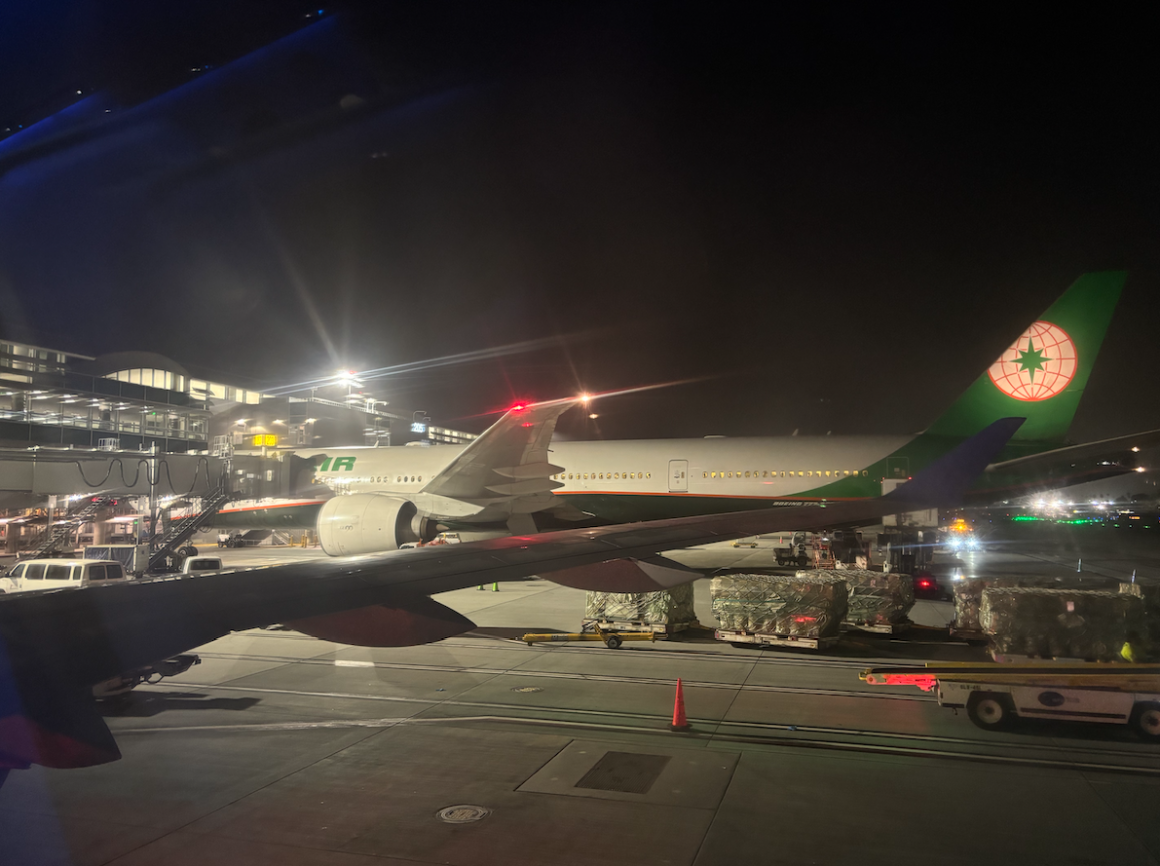
Following the second service, the crew prepped the cabin for our initial descent into LAX. Thanks to favorable upper-level winds, we were running significantly ahead of schedule. However, our hopes of an early arrival were dashed when the captain informed us that ATC was slowing all arrivals wayyyyyy down due to heavy traffic.
Sure enough, our final approach seemed to take an eternity. After finally receiving clearance to land on Runway 25R, we (very) slowly made our way to touchdown. With wheels down at 2137 local time, we then taxied to Gate 201B. Flight time was 4:56.
As usual, LAX was a hot mess. We had to wait for our gate to open, causing a 15-minute hold short of gate arrival. Finally, at 2158, we arrived at the gate, sandwiched between an EVA Air Boeing 777 and a Qantas A380. Although our arrival was 28 minutes behind schedule, Breeze is in no way to blame for the delay. LAX is, well…LAX.
We gathered our belongings, said goodbye to the crew, and walked up the jetbridge into the chaotic terminal. Navigating through a mass of humanity, we made our way to the shuttle bus stop, which would take us to baggage claim. Thirty minutes later, we arrived at baggage claim.
Unfortunately, we had to wait nearly 90 minutes for our bags. Again, I do not blame Breeze Airways for this, as passengers from other airlines experienced similar delays. Instead, we chalked it up to the inefficient horror show that is LAX.
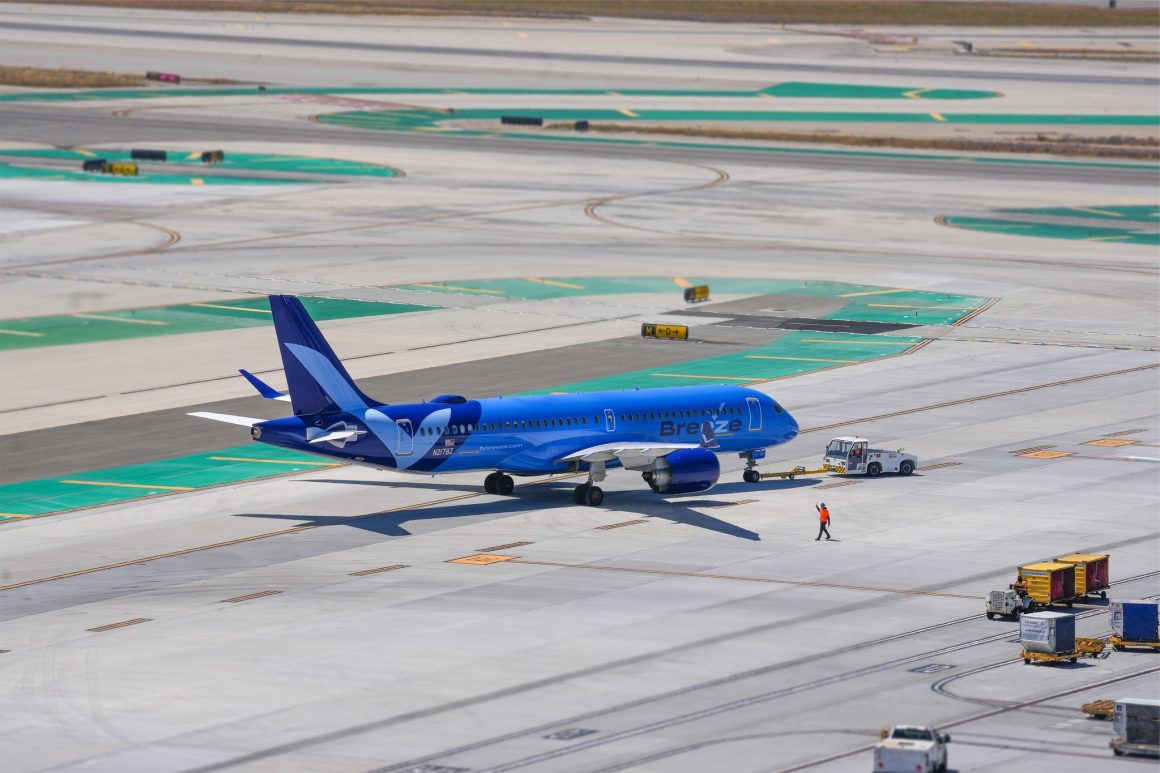
In a Sky Full of Competitors, Breeze Airways Stands Out

My impression of Breeze Airways is that they offer something truly exceptional. As a frequent flyer with ULCCs, I know what to expect, but Breeze stands out even among its low-cost rivals.
Although Breeze is firmly in the ULCC category, it distinguishes itself with fantastic service and a fresh, modern product. And my flight to LAX wasn’t just a fluke experience. Exactly one week later, we encountered the same cabin crew on our redeye flight back to CHS. On the shuttle bus to the gate, the FA that had given my son the M&Ms recognized him, gave him a high five and later offered him another box of M&Ms, which he gladly accepted.
Perhaps it doesn’t take much to impress me, but this certainly did.
If this level of service is consistent company-wide, Breeze Airways is set for long-term success. Despite being a young company still in search of its first profitable quarter (though it recently saw its first profitable month), Breeze Airways clearly has a winning formula.
One might even say flying with them was a Seriously Nice™️ Breeze.
… I’ll see myself out.
